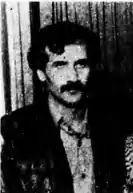Mehdi Abrishamchi
Mehdi Abrishamchi (Persian: مهدی ابریشمچی) is a member of the People's Mujahedin of Iran (MEK) who has been described as "the right hand man of Massoud Rajavi", the group's leader.[2] He is the former spouse of the group's current leader, Maryam Rajavi, whom he divorced so that she could become the spouse of Massoud Rajavi.[3]
Mehdi Abrishamchi | |
|---|---|
 Abrishamchi in 1980 | |
| Born | 1947 (age 73–74)[1] |
| Alma mater | University of Tehran |
| Organization | People's Mujahedin of Iran |
| Spouse(s) | Azar Khiabani (m. 1985) |
Life and career
Abrishamchi was born into a bazaari family, and studied chemistry at University of Tehran.[1] He became a member of Hojjatieh[4] and participated in June 5, 1963, demonstrations in Iran, joining the People's Mujahedin of Iran in 1969. He was subsequently sentenced to imprisonment in 1972 for his activities with the MEK, and spent in jail until 1979. Shortly after Iranian Revolution, he became one of the senior members of the MEK.[1] During Iran–Iraq War, Abrishamchi was a unit commander in the 'National Liberation Army of Iran', the military wing of the MEK fighting against Iranian Armed Forces.[5] He is now an official in the MEK's political wing named National Council of Resistance of Iran.[6] In 1985, due to the 'ideological revolution' within the MEK, he divorced his wife Maryam Qajar who married Massoud Rajavi.[3] Shortly after, he married to Mousa Khiabani's younger sister Azar.[1]
Electoral history
| Year | Election | Votes | % | Rank | Notes |
|---|---|---|---|---|---|
| 1980 | Parliament | 390,683 | 18.3 | 46th | Lost[7] |
References
- Ervand Abrahamian (1989), Radical Islam: the Iranian Mojahedin, Society and culture in the modern Middle East, 3, I.B.Tauris, pp. 172–174, 251–253, ISBN 9781850430773
- Jonathan D. Hutzley (2004). Unmasking Terror: A Global Review of Terrorist Activities. 1. Jamestown Foundation. p. 410. ISBN 9780967500935.
- Connie Bruck (2006). "Exiles: How Iran's expatriates are gaming the nuclear threat". The New Yorker. F-R Publishing Corporation. 82 (1–11): 54–55.
This transition was epitomized by Rajavi's involvement, in 1985, with Maryam Azodanlu. Maryam was already married, to Mehdi Abrishamchi, one of Rajavi's close associates. Rajavi overcame that fact by making the romance a matter of revolutionary necessity. First, he said that he was making Maryam his co-leader-and that it would transform thinking about the role of women throughout the Muslim world. Then, about a month later, it was announced that Maryam was divorced from Abrishamchi and that the two co-leaders would marry, in order to further the "ideological revolution."
- Mehdi Khalaji (January 2008), Apocalyptic Politics: On the Rationality of Iranian Policy (PDF), Iran Policy Focus, Washington Institute for Near East Policy, p. 12
- Ralph Joseph (22 May 1988), "Iranian exiles form rebel army", United Press International, retrieved 30 March 2018
- Vasudevan Sridharan (1 July 2014), "Iran About to Complete Secret Nuclear Facility, Claims Dissident Group", International Business Times, retrieved 30 March 2018
- Ervand Abrahamian (1989), Radical Islam: the Iranian Mojahedin, Society and culture in the modern Middle East, 3, I.B.Tauris, p. 195, Table 6; pp. 203–205, Table 8, ISBN 9781850430773